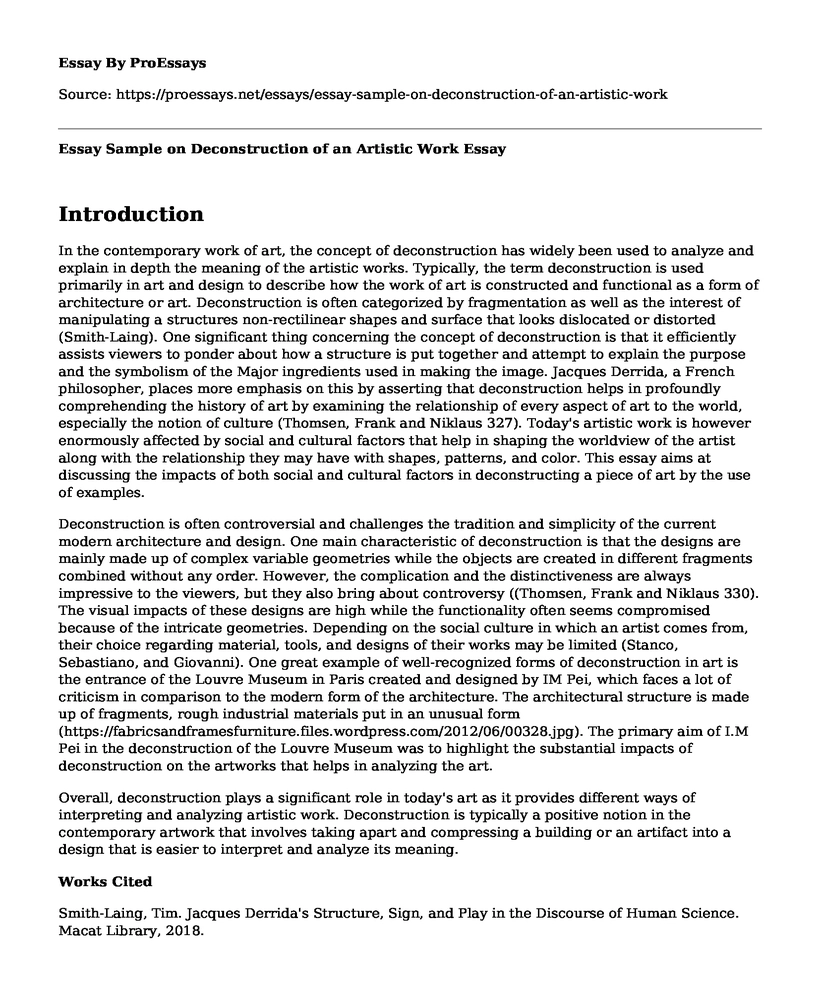Introduction
In the contemporary work of art, the concept of deconstruction has widely been used to analyze and explain in depth the meaning of the artistic works. Typically, the term deconstruction is used primarily in art and design to describe how the work of art is constructed and functional as a form of architecture or art. Deconstruction is often categorized by fragmentation as well as the interest of manipulating a structures non-rectilinear shapes and surface that looks dislocated or distorted (Smith-Laing). One significant thing concerning the concept of deconstruction is that it efficiently assists viewers to ponder about how a structure is put together and attempt to explain the purpose and the symbolism of the Major ingredients used in making the image. Jacques Derrida, a French philosopher, places more emphasis on this by asserting that deconstruction helps in profoundly comprehending the history of art by examining the relationship of every aspect of art to the world, especially the notion of culture (Thomsen, Frank and Niklaus 327). Today's artistic work is however enormously affected by social and cultural factors that help in shaping the worldview of the artist along with the relationship they may have with shapes, patterns, and color. This essay aims at discussing the impacts of both social and cultural factors in deconstructing a piece of art by the use of examples.
Deconstruction is often controversial and challenges the tradition and simplicity of the current modern architecture and design. One main characteristic of deconstruction is that the designs are mainly made up of complex variable geometries while the objects are created in different fragments combined without any order. However, the complication and the distinctiveness are always impressive to the viewers, but they also bring about controversy ((Thomsen, Frank and Niklaus 330). The visual impacts of these designs are high while the functionality often seems compromised because of the intricate geometries. Depending on the social culture in which an artist comes from, their choice regarding material, tools, and designs of their works may be limited (Stanco, Sebastiano, and Giovanni). One great example of well-recognized forms of deconstruction in art is the entrance of the Louvre Museum in Paris created and designed by IM Pei, which faces a lot of criticism in comparison to the modern form of the architecture. The architectural structure is made up of fragments, rough industrial materials put in an unusual form (https://fabricsandframesfurniture.files.wordpress.com/2012/06/00328.jpg). The primary aim of I.M Pei in the deconstruction of the Louvre Museum was to highlight the substantial impacts of deconstruction on the artworks that helps in analyzing the art.
Overall, deconstruction plays a significant role in today's art as it provides different ways of interpreting and analyzing artistic work. Deconstruction is typically a positive notion in the contemporary artwork that involves taking apart and compressing a building or an artifact into a design that is easier to interpret and analyze its meaning.
Works Cited
Smith-Laing, Tim. Jacques Derrida's Structure, Sign, and Play in the Discourse of Human Science. Macat Library, 2018.
Stanco, Filippo, Sebastiano Battiato, and Giovanni Gallo, eds. Digital imaging for cultural heritage preservation: Analysis, restoration, and reconstruction of ancient artworks. CRC Press, 2015.Thomsen, Andre, Frank Schultmann, and Niklaus Kohler. "Deconstruction, demolition and destruction." (2017): 327-332.
Cite this page
Essay Sample on Deconstruction of an Artistic Work. (2022, Nov 25). Retrieved from https://proessays.net/essays/essay-sample-on-deconstruction-of-an-artistic-work
If you are the original author of this essay and no longer wish to have it published on the ProEssays website, please click below to request its removal:
- Life is About Perseverance - Creative Writing Example
- Essay Sample on The Importance of Music in Rituals
- Essay Sample on Social Media Plan for GE
- Pretty Hurts: Analyzing Beyonce Knowles' 2013 Music Video - Essay Sample
- Corrosion: Main Problems in Naval Architecture - Essay Sample
- Essay Example on Blow-Up: Seduction, Photography, & Mystery
- Riders to the Sea Movie Review Script Analysis







